A Report on Contract and Negligence Law in Business: ACNB Analysis
VerifiedAdded on 2019/12/03
|13
|4241
|153
Report
AI Summary
This report provides a comprehensive analysis of contract law and negligence within a business context. It begins by outlining the essential elements required for contract formation, including offer and acceptance, consideration, and the intention to create legal relations. Different types of contracts, such as face-to-face, written, and distance selling contracts, are examined, along with their implications. The report then applies these elements to case studies, analyzing contractual terms (conditions, warranties, exclusion clauses, and innominate terms) and evaluating the impact of expressed and implied terms. The concept of promissory estoppel is also discussed. Furthermore, the report delves into the tort of negligence, advising on the recovery of losses, contrasting the nature of liability in contract and tort, and explaining vicarious liability, including when businesses are and are not liable for employee actions. The analysis is supported by relevant case law, providing a practical understanding of contract and negligence principles.
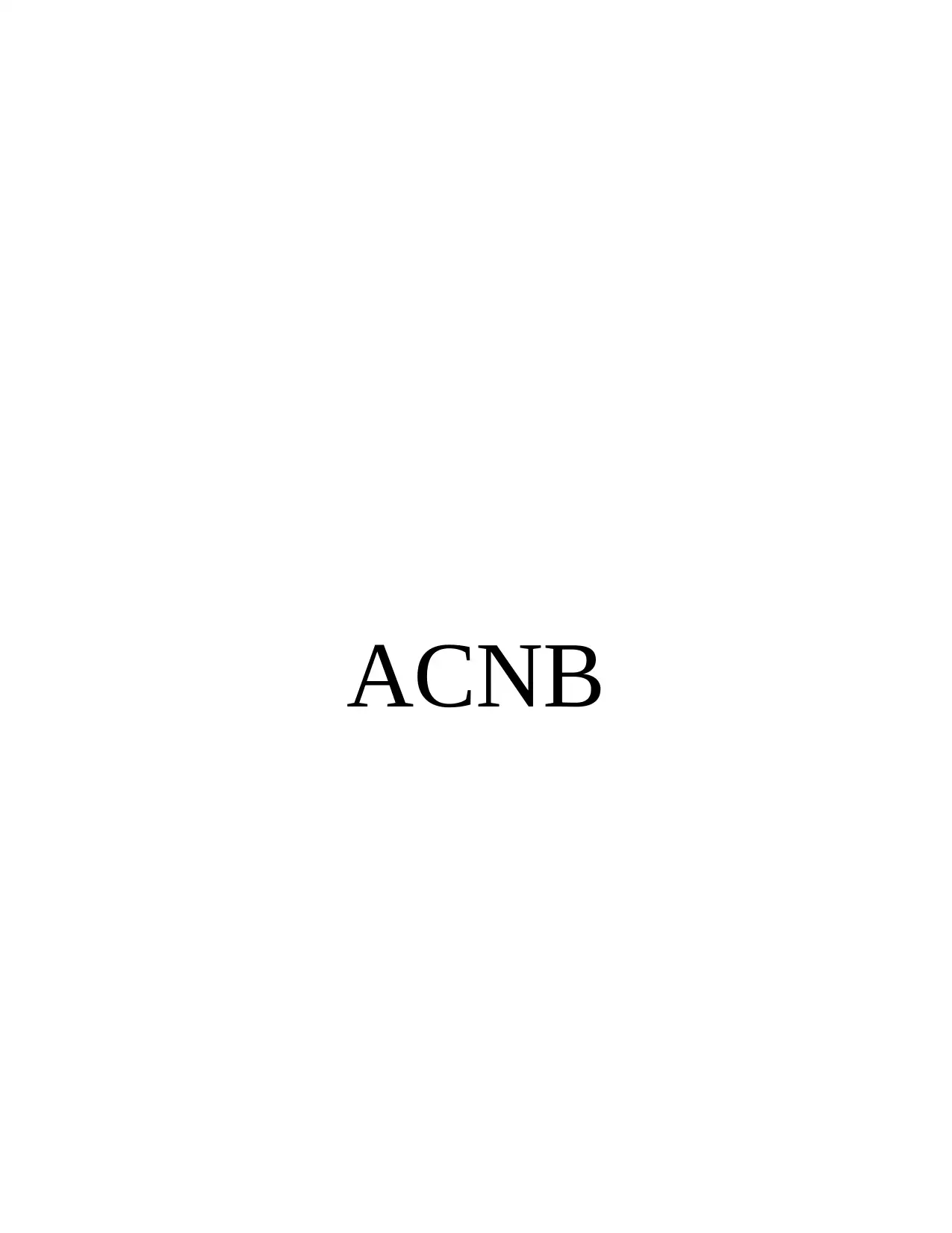
ACNB
Paraphrase This Document
Need a fresh take? Get an instant paraphrase of this document with our AI Paraphraser
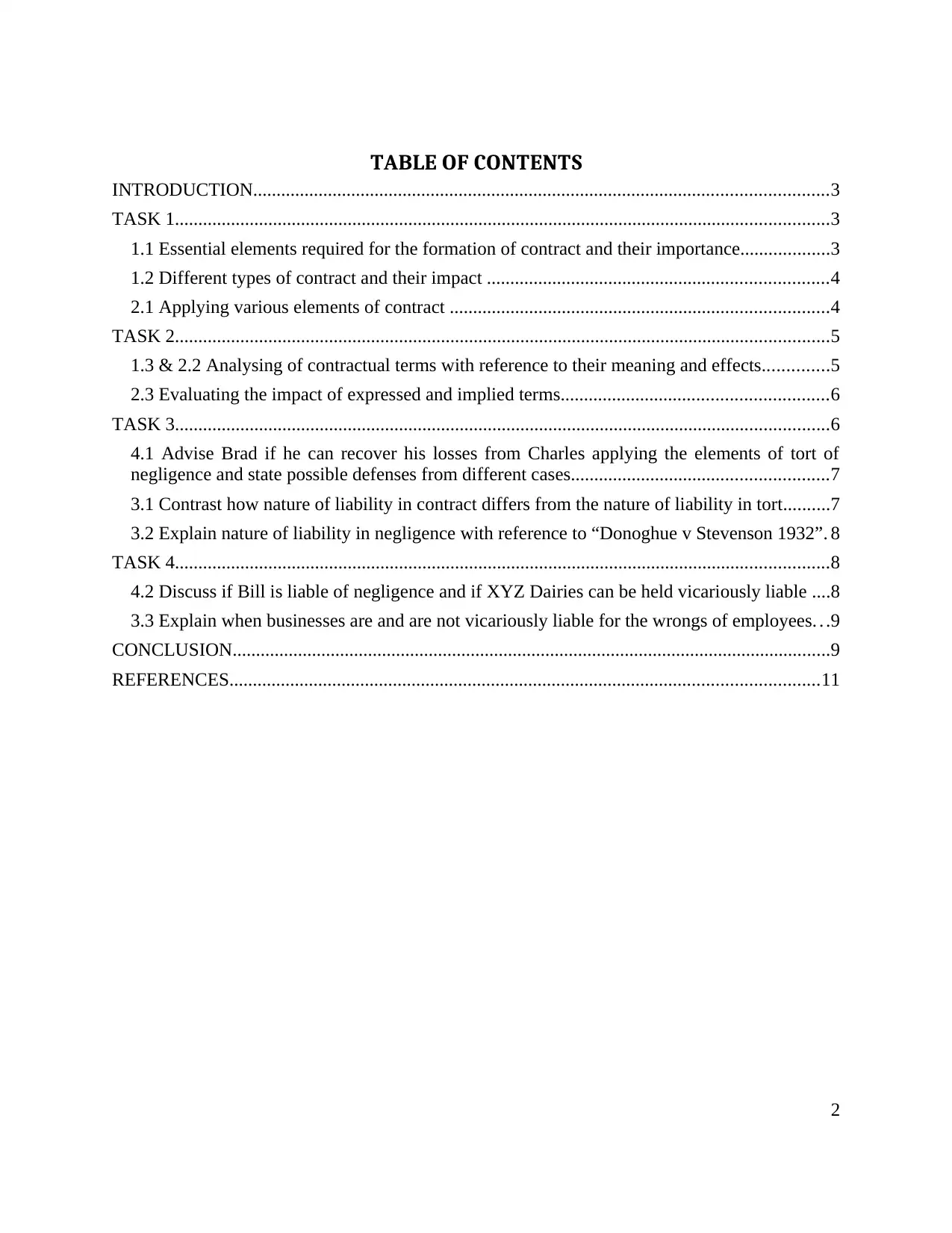
TABLE OF CONTENTS
INTRODUCTION...........................................................................................................................3
TASK 1............................................................................................................................................3
1.1 Essential elements required for the formation of contract and their importance...................3
1.2 Different types of contract and their impact .........................................................................4
2.1 Applying various elements of contract .................................................................................4
TASK 2............................................................................................................................................5
1.3 & 2.2 Analysing of contractual terms with reference to their meaning and effects..............5
2.3 Evaluating the impact of expressed and implied terms.........................................................6
TASK 3............................................................................................................................................6
4.1 Advise Brad if he can recover his losses from Charles applying the elements of tort of
negligence and state possible defenses from different cases.......................................................7
3.1 Contrast how nature of liability in contract differs from the nature of liability in tort..........7
3.2 Explain nature of liability in negligence with reference to “Donoghue v Stevenson 1932”. 8
TASK 4............................................................................................................................................8
4.2 Discuss if Bill is liable of negligence and if XYZ Dairies can be held vicariously liable ....8
3.3 Explain when businesses are and are not vicariously liable for the wrongs of employees. . .9
CONCLUSION................................................................................................................................9
REFERENCES..............................................................................................................................11
2
INTRODUCTION...........................................................................................................................3
TASK 1............................................................................................................................................3
1.1 Essential elements required for the formation of contract and their importance...................3
1.2 Different types of contract and their impact .........................................................................4
2.1 Applying various elements of contract .................................................................................4
TASK 2............................................................................................................................................5
1.3 & 2.2 Analysing of contractual terms with reference to their meaning and effects..............5
2.3 Evaluating the impact of expressed and implied terms.........................................................6
TASK 3............................................................................................................................................6
4.1 Advise Brad if he can recover his losses from Charles applying the elements of tort of
negligence and state possible defenses from different cases.......................................................7
3.1 Contrast how nature of liability in contract differs from the nature of liability in tort..........7
3.2 Explain nature of liability in negligence with reference to “Donoghue v Stevenson 1932”. 8
TASK 4............................................................................................................................................8
4.2 Discuss if Bill is liable of negligence and if XYZ Dairies can be held vicariously liable ....8
3.3 Explain when businesses are and are not vicariously liable for the wrongs of employees. . .9
CONCLUSION................................................................................................................................9
REFERENCES..............................................................................................................................11
2
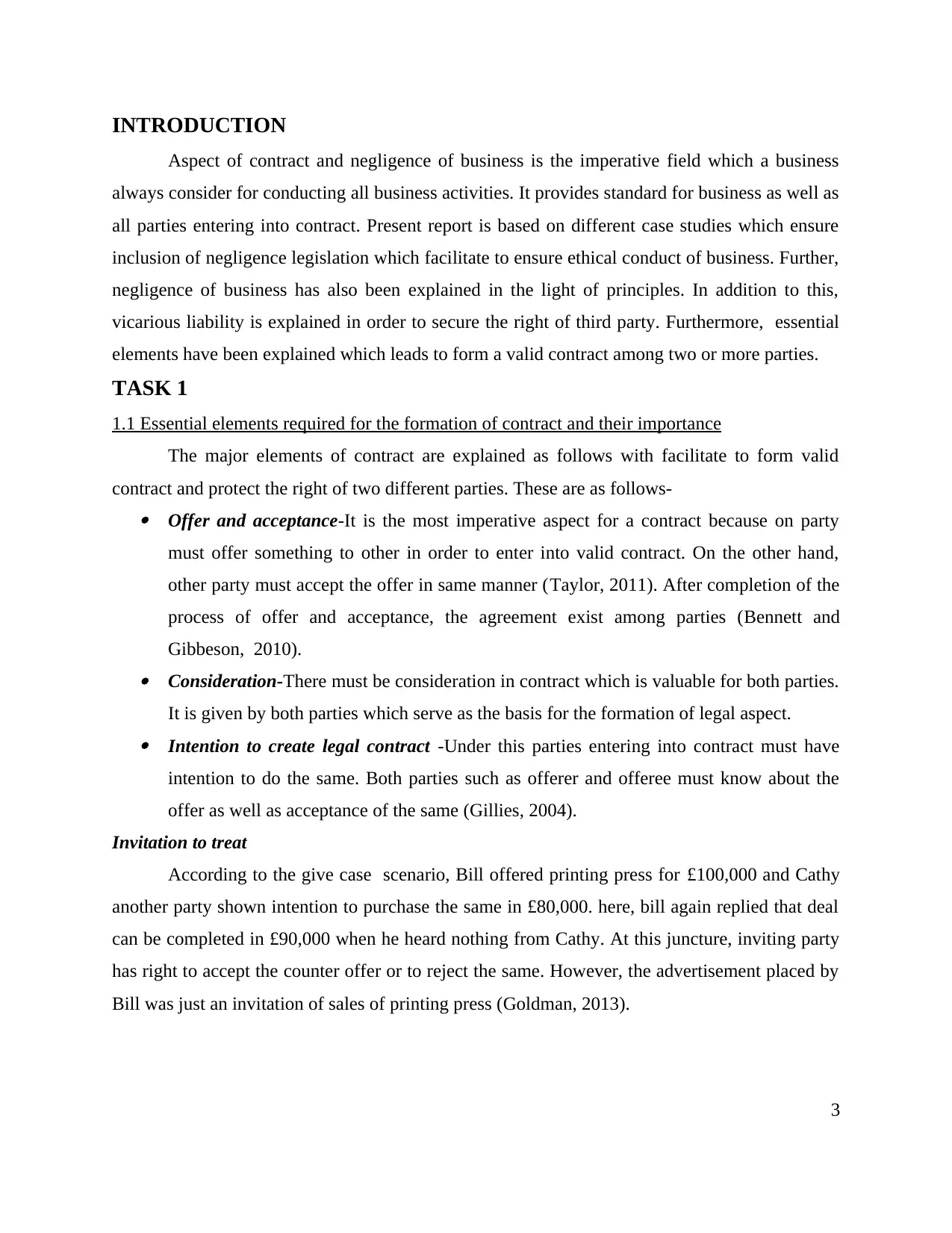
INTRODUCTION
Aspect of contract and negligence of business is the imperative field which a business
always consider for conducting all business activities. It provides standard for business as well as
all parties entering into contract. Present report is based on different case studies which ensure
inclusion of negligence legislation which facilitate to ensure ethical conduct of business. Further,
negligence of business has also been explained in the light of principles. In addition to this,
vicarious liability is explained in order to secure the right of third party. Furthermore, essential
elements have been explained which leads to form a valid contract among two or more parties.
TASK 1
1.1 Essential elements required for the formation of contract and their importance
The major elements of contract are explained as follows with facilitate to form valid
contract and protect the right of two different parties. These are as follows- Offer and acceptance-It is the most imperative aspect for a contract because on party
must offer something to other in order to enter into valid contract. On the other hand,
other party must accept the offer in same manner (Taylor, 2011). After completion of the
process of offer and acceptance, the agreement exist among parties (Bennett and
Gibbeson, 2010). Consideration-There must be consideration in contract which is valuable for both parties.
It is given by both parties which serve as the basis for the formation of legal aspect. Intention to create legal contract -Under this parties entering into contract must have
intention to do the same. Both parties such as offerer and offeree must know about the
offer as well as acceptance of the same (Gillies, 2004).
Invitation to treat
According to the give case scenario, Bill offered printing press for £100,000 and Cathy
another party shown intention to purchase the same in £80,000. here, bill again replied that deal
can be completed in £90,000 when he heard nothing from Cathy. At this juncture, inviting party
has right to accept the counter offer or to reject the same. However, the advertisement placed by
Bill was just an invitation of sales of printing press (Goldman, 2013).
3
Aspect of contract and negligence of business is the imperative field which a business
always consider for conducting all business activities. It provides standard for business as well as
all parties entering into contract. Present report is based on different case studies which ensure
inclusion of negligence legislation which facilitate to ensure ethical conduct of business. Further,
negligence of business has also been explained in the light of principles. In addition to this,
vicarious liability is explained in order to secure the right of third party. Furthermore, essential
elements have been explained which leads to form a valid contract among two or more parties.
TASK 1
1.1 Essential elements required for the formation of contract and their importance
The major elements of contract are explained as follows with facilitate to form valid
contract and protect the right of two different parties. These are as follows- Offer and acceptance-It is the most imperative aspect for a contract because on party
must offer something to other in order to enter into valid contract. On the other hand,
other party must accept the offer in same manner (Taylor, 2011). After completion of the
process of offer and acceptance, the agreement exist among parties (Bennett and
Gibbeson, 2010). Consideration-There must be consideration in contract which is valuable for both parties.
It is given by both parties which serve as the basis for the formation of legal aspect. Intention to create legal contract -Under this parties entering into contract must have
intention to do the same. Both parties such as offerer and offeree must know about the
offer as well as acceptance of the same (Gillies, 2004).
Invitation to treat
According to the give case scenario, Bill offered printing press for £100,000 and Cathy
another party shown intention to purchase the same in £80,000. here, bill again replied that deal
can be completed in £90,000 when he heard nothing from Cathy. At this juncture, inviting party
has right to accept the counter offer or to reject the same. However, the advertisement placed by
Bill was just an invitation of sales of printing press (Goldman, 2013).
3
⊘ This is a preview!⊘
Do you want full access?
Subscribe today to unlock all pages.

Trusted by 1+ million students worldwide
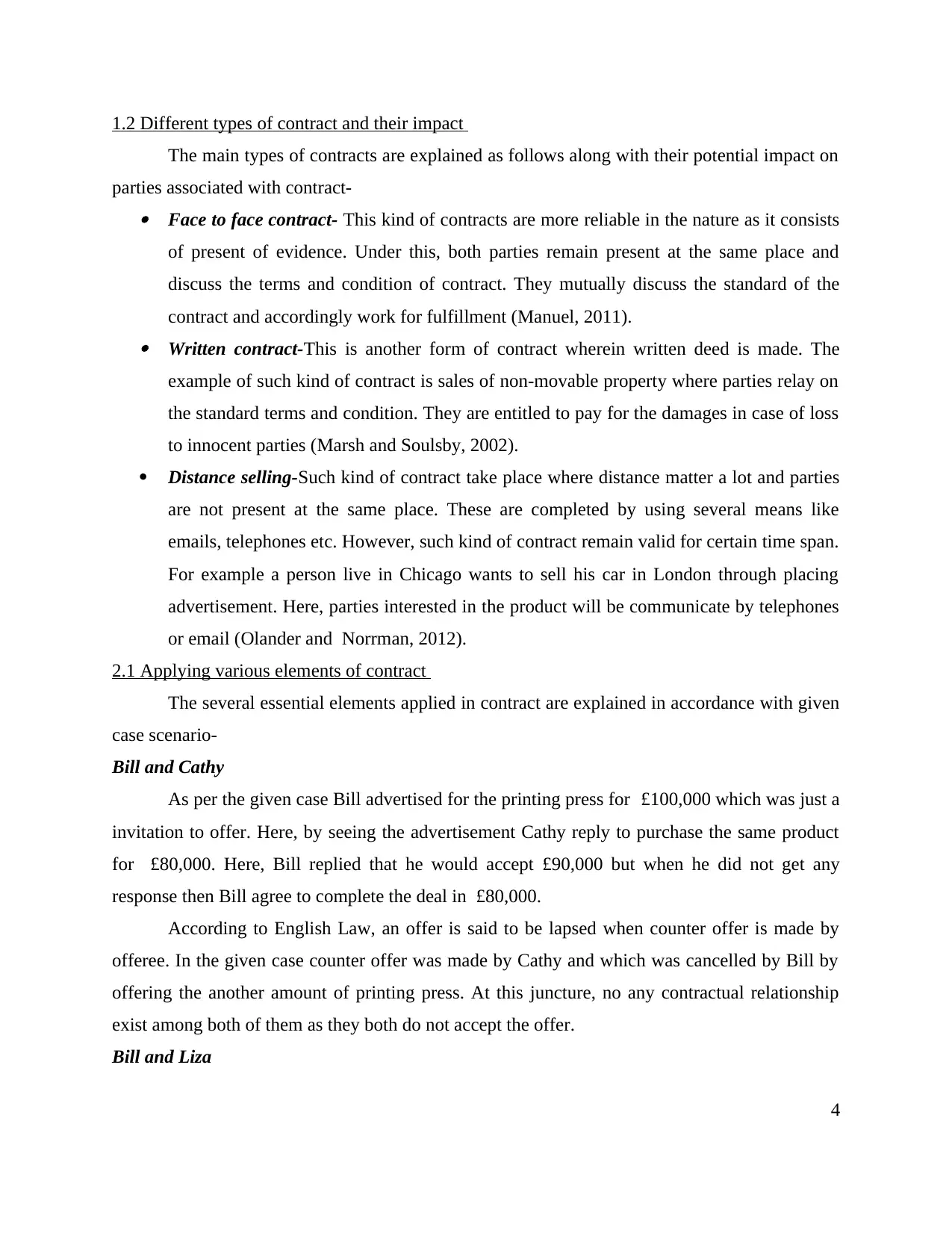
1.2 Different types of contract and their impact
The main types of contracts are explained as follows along with their potential impact on
parties associated with contract- Face to face contract- This kind of contracts are more reliable in the nature as it consists
of present of evidence. Under this, both parties remain present at the same place and
discuss the terms and condition of contract. They mutually discuss the standard of the
contract and accordingly work for fulfillment (Manuel, 2011). Written contract-This is another form of contract wherein written deed is made. The
example of such kind of contract is sales of non-movable property where parties relay on
the standard terms and condition. They are entitled to pay for the damages in case of loss
to innocent parties (Marsh and Soulsby, 2002).
Distance selling-Such kind of contract take place where distance matter a lot and parties
are not present at the same place. These are completed by using several means like
emails, telephones etc. However, such kind of contract remain valid for certain time span.
For example a person live in Chicago wants to sell his car in London through placing
advertisement. Here, parties interested in the product will be communicate by telephones
or email (Olander and Norrman, 2012).
2.1 Applying various elements of contract
The several essential elements applied in contract are explained in accordance with given
case scenario-
Bill and Cathy
As per the given case Bill advertised for the printing press for £100,000 which was just a
invitation to offer. Here, by seeing the advertisement Cathy reply to purchase the same product
for £80,000. Here, Bill replied that he would accept £90,000 but when he did not get any
response then Bill agree to complete the deal in £80,000.
According to English Law, an offer is said to be lapsed when counter offer is made by
offeree. In the given case counter offer was made by Cathy and which was cancelled by Bill by
offering the another amount of printing press. At this juncture, no any contractual relationship
exist among both of them as they both do not accept the offer.
Bill and Liza
4
The main types of contracts are explained as follows along with their potential impact on
parties associated with contract- Face to face contract- This kind of contracts are more reliable in the nature as it consists
of present of evidence. Under this, both parties remain present at the same place and
discuss the terms and condition of contract. They mutually discuss the standard of the
contract and accordingly work for fulfillment (Manuel, 2011). Written contract-This is another form of contract wherein written deed is made. The
example of such kind of contract is sales of non-movable property where parties relay on
the standard terms and condition. They are entitled to pay for the damages in case of loss
to innocent parties (Marsh and Soulsby, 2002).
Distance selling-Such kind of contract take place where distance matter a lot and parties
are not present at the same place. These are completed by using several means like
emails, telephones etc. However, such kind of contract remain valid for certain time span.
For example a person live in Chicago wants to sell his car in London through placing
advertisement. Here, parties interested in the product will be communicate by telephones
or email (Olander and Norrman, 2012).
2.1 Applying various elements of contract
The several essential elements applied in contract are explained in accordance with given
case scenario-
Bill and Cathy
As per the given case Bill advertised for the printing press for £100,000 which was just a
invitation to offer. Here, by seeing the advertisement Cathy reply to purchase the same product
for £80,000. Here, Bill replied that he would accept £90,000 but when he did not get any
response then Bill agree to complete the deal in £80,000.
According to English Law, an offer is said to be lapsed when counter offer is made by
offeree. In the given case counter offer was made by Cathy and which was cancelled by Bill by
offering the another amount of printing press. At this juncture, no any contractual relationship
exist among both of them as they both do not accept the offer.
Bill and Liza
4
Paraphrase This Document
Need a fresh take? Get an instant paraphrase of this document with our AI Paraphraser
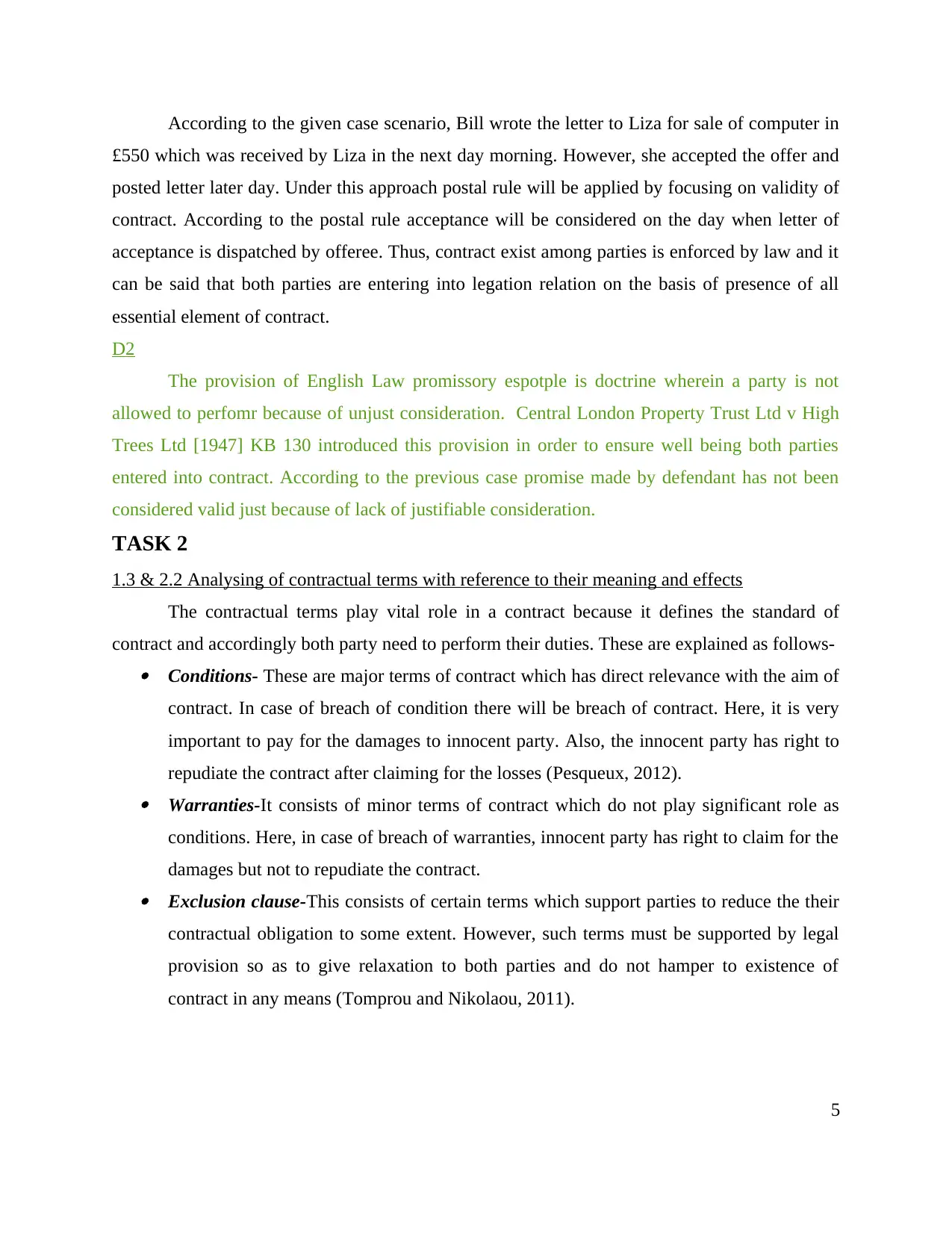
According to the given case scenario, Bill wrote the letter to Liza for sale of computer in
£550 which was received by Liza in the next day morning. However, she accepted the offer and
posted letter later day. Under this approach postal rule will be applied by focusing on validity of
contract. According to the postal rule acceptance will be considered on the day when letter of
acceptance is dispatched by offeree. Thus, contract exist among parties is enforced by law and it
can be said that both parties are entering into legation relation on the basis of presence of all
essential element of contract.
D2
The provision of English Law promissory espotple is doctrine wherein a party is not
allowed to perfomr because of unjust consideration. Central London Property Trust Ltd v High
Trees Ltd [1947] KB 130 introduced this provision in order to ensure well being both parties
entered into contract. According to the previous case promise made by defendant has not been
considered valid just because of lack of justifiable consideration.
TASK 2
1.3 & 2.2 Analysing of contractual terms with reference to their meaning and effects
The contractual terms play vital role in a contract because it defines the standard of
contract and accordingly both party need to perform their duties. These are explained as follows- Conditions- These are major terms of contract which has direct relevance with the aim of
contract. In case of breach of condition there will be breach of contract. Here, it is very
important to pay for the damages to innocent party. Also, the innocent party has right to
repudiate the contract after claiming for the losses (Pesqueux, 2012). Warranties-It consists of minor terms of contract which do not play significant role as
conditions. Here, in case of breach of warranties, innocent party has right to claim for the
damages but not to repudiate the contract. Exclusion clause-This consists of certain terms which support parties to reduce the their
contractual obligation to some extent. However, such terms must be supported by legal
provision so as to give relaxation to both parties and do not hamper to existence of
contract in any means (Tomprou and Nikolaou, 2011).
5
£550 which was received by Liza in the next day morning. However, she accepted the offer and
posted letter later day. Under this approach postal rule will be applied by focusing on validity of
contract. According to the postal rule acceptance will be considered on the day when letter of
acceptance is dispatched by offeree. Thus, contract exist among parties is enforced by law and it
can be said that both parties are entering into legation relation on the basis of presence of all
essential element of contract.
D2
The provision of English Law promissory espotple is doctrine wherein a party is not
allowed to perfomr because of unjust consideration. Central London Property Trust Ltd v High
Trees Ltd [1947] KB 130 introduced this provision in order to ensure well being both parties
entered into contract. According to the previous case promise made by defendant has not been
considered valid just because of lack of justifiable consideration.
TASK 2
1.3 & 2.2 Analysing of contractual terms with reference to their meaning and effects
The contractual terms play vital role in a contract because it defines the standard of
contract and accordingly both party need to perform their duties. These are explained as follows- Conditions- These are major terms of contract which has direct relevance with the aim of
contract. In case of breach of condition there will be breach of contract. Here, it is very
important to pay for the damages to innocent party. Also, the innocent party has right to
repudiate the contract after claiming for the losses (Pesqueux, 2012). Warranties-It consists of minor terms of contract which do not play significant role as
conditions. Here, in case of breach of warranties, innocent party has right to claim for the
damages but not to repudiate the contract. Exclusion clause-This consists of certain terms which support parties to reduce the their
contractual obligation to some extent. However, such terms must be supported by legal
provision so as to give relaxation to both parties and do not hamper to existence of
contract in any means (Tomprou and Nikolaou, 2011).
5
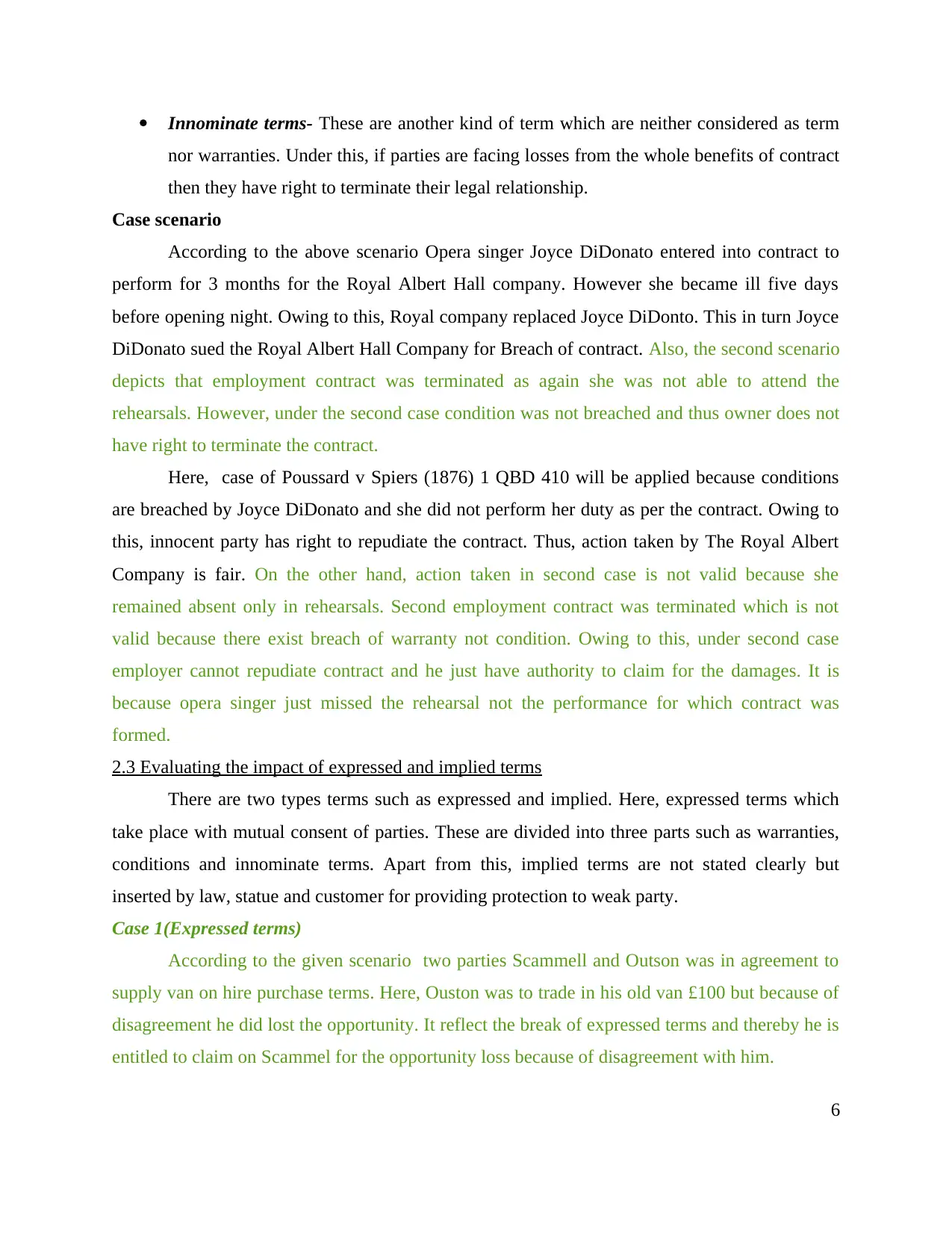
Innominate terms- These are another kind of term which are neither considered as term
nor warranties. Under this, if parties are facing losses from the whole benefits of contract
then they have right to terminate their legal relationship.
Case scenario
According to the above scenario Opera singer Joyce DiDonato entered into contract to
perform for 3 months for the Royal Albert Hall company. However she became ill five days
before opening night. Owing to this, Royal company replaced Joyce DiDonto. This in turn Joyce
DiDonato sued the Royal Albert Hall Company for Breach of contract. Also, the second scenario
depicts that employment contract was terminated as again she was not able to attend the
rehearsals. However, under the second case condition was not breached and thus owner does not
have right to terminate the contract.
Here, case of Poussard v Spiers (1876) 1 QBD 410 will be applied because conditions
are breached by Joyce DiDonato and she did not perform her duty as per the contract. Owing to
this, innocent party has right to repudiate the contract. Thus, action taken by The Royal Albert
Company is fair. On the other hand, action taken in second case is not valid because she
remained absent only in rehearsals. Second employment contract was terminated which is not
valid because there exist breach of warranty not condition. Owing to this, under second case
employer cannot repudiate contract and he just have authority to claim for the damages. It is
because opera singer just missed the rehearsal not the performance for which contract was
formed.
2.3 Evaluating the impact of expressed and implied terms
There are two types terms such as expressed and implied. Here, expressed terms which
take place with mutual consent of parties. These are divided into three parts such as warranties,
conditions and innominate terms. Apart from this, implied terms are not stated clearly but
inserted by law, statue and customer for providing protection to weak party.
Case 1(Expressed terms)
According to the given scenario two parties Scammell and Outson was in agreement to
supply van on hire purchase terms. Here, Ouston was to trade in his old van £100 but because of
disagreement he did lost the opportunity. It reflect the break of expressed terms and thereby he is
entitled to claim on Scammel for the opportunity loss because of disagreement with him.
6
nor warranties. Under this, if parties are facing losses from the whole benefits of contract
then they have right to terminate their legal relationship.
Case scenario
According to the above scenario Opera singer Joyce DiDonato entered into contract to
perform for 3 months for the Royal Albert Hall company. However she became ill five days
before opening night. Owing to this, Royal company replaced Joyce DiDonto. This in turn Joyce
DiDonato sued the Royal Albert Hall Company for Breach of contract. Also, the second scenario
depicts that employment contract was terminated as again she was not able to attend the
rehearsals. However, under the second case condition was not breached and thus owner does not
have right to terminate the contract.
Here, case of Poussard v Spiers (1876) 1 QBD 410 will be applied because conditions
are breached by Joyce DiDonato and she did not perform her duty as per the contract. Owing to
this, innocent party has right to repudiate the contract. Thus, action taken by The Royal Albert
Company is fair. On the other hand, action taken in second case is not valid because she
remained absent only in rehearsals. Second employment contract was terminated which is not
valid because there exist breach of warranty not condition. Owing to this, under second case
employer cannot repudiate contract and he just have authority to claim for the damages. It is
because opera singer just missed the rehearsal not the performance for which contract was
formed.
2.3 Evaluating the impact of expressed and implied terms
There are two types terms such as expressed and implied. Here, expressed terms which
take place with mutual consent of parties. These are divided into three parts such as warranties,
conditions and innominate terms. Apart from this, implied terms are not stated clearly but
inserted by law, statue and customer for providing protection to weak party.
Case 1(Expressed terms)
According to the given scenario two parties Scammell and Outson was in agreement to
supply van on hire purchase terms. Here, Ouston was to trade in his old van £100 but because of
disagreement he did lost the opportunity. It reflect the break of expressed terms and thereby he is
entitled to claim on Scammel for the opportunity loss because of disagreement with him.
6
⊘ This is a preview!⊘
Do you want full access?
Subscribe today to unlock all pages.

Trusted by 1+ million students worldwide
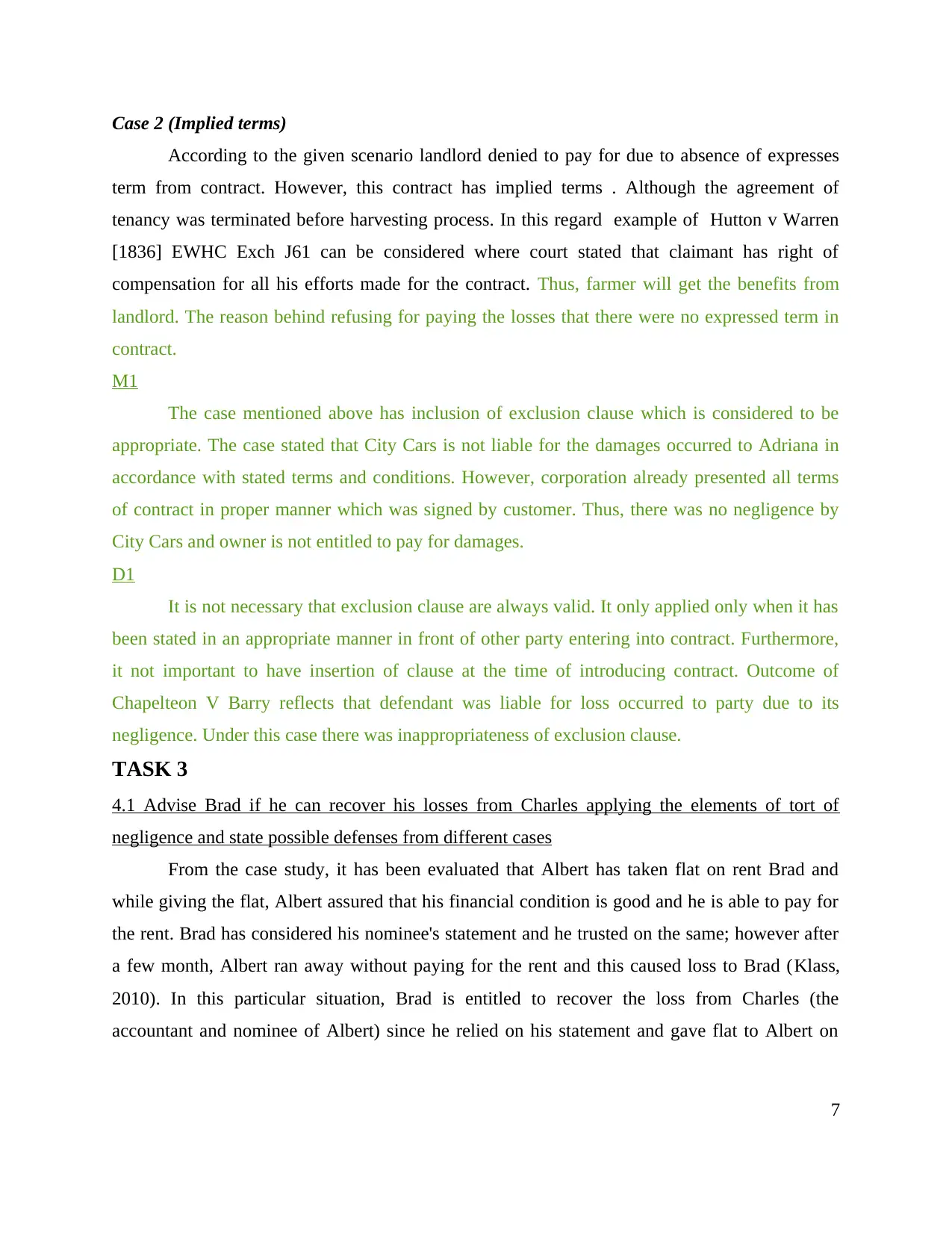
Case 2 (Implied terms)
According to the given scenario landlord denied to pay for due to absence of expresses
term from contract. However, this contract has implied terms . Although the agreement of
tenancy was terminated before harvesting process. In this regard example of Hutton v Warren
[1836] EWHC Exch J61 can be considered where court stated that claimant has right of
compensation for all his efforts made for the contract. Thus, farmer will get the benefits from
landlord. The reason behind refusing for paying the losses that there were no expressed term in
contract.
M1
The case mentioned above has inclusion of exclusion clause which is considered to be
appropriate. The case stated that City Cars is not liable for the damages occurred to Adriana in
accordance with stated terms and conditions. However, corporation already presented all terms
of contract in proper manner which was signed by customer. Thus, there was no negligence by
City Cars and owner is not entitled to pay for damages.
D1
It is not necessary that exclusion clause are always valid. It only applied only when it has
been stated in an appropriate manner in front of other party entering into contract. Furthermore,
it not important to have insertion of clause at the time of introducing contract. Outcome of
Chapelteon V Barry reflects that defendant was liable for loss occurred to party due to its
negligence. Under this case there was inappropriateness of exclusion clause.
TASK 3
4.1 Advise Brad if he can recover his losses from Charles applying the elements of tort of
negligence and state possible defenses from different cases
From the case study, it has been evaluated that Albert has taken flat on rent Brad and
while giving the flat, Albert assured that his financial condition is good and he is able to pay for
the rent. Brad has considered his nominee's statement and he trusted on the same; however after
a few month, Albert ran away without paying for the rent and this caused loss to Brad (Klass,
2010). In this particular situation, Brad is entitled to recover the loss from Charles (the
accountant and nominee of Albert) since he relied on his statement and gave flat to Albert on
7
According to the given scenario landlord denied to pay for due to absence of expresses
term from contract. However, this contract has implied terms . Although the agreement of
tenancy was terminated before harvesting process. In this regard example of Hutton v Warren
[1836] EWHC Exch J61 can be considered where court stated that claimant has right of
compensation for all his efforts made for the contract. Thus, farmer will get the benefits from
landlord. The reason behind refusing for paying the losses that there were no expressed term in
contract.
M1
The case mentioned above has inclusion of exclusion clause which is considered to be
appropriate. The case stated that City Cars is not liable for the damages occurred to Adriana in
accordance with stated terms and conditions. However, corporation already presented all terms
of contract in proper manner which was signed by customer. Thus, there was no negligence by
City Cars and owner is not entitled to pay for damages.
D1
It is not necessary that exclusion clause are always valid. It only applied only when it has
been stated in an appropriate manner in front of other party entering into contract. Furthermore,
it not important to have insertion of clause at the time of introducing contract. Outcome of
Chapelteon V Barry reflects that defendant was liable for loss occurred to party due to its
negligence. Under this case there was inappropriateness of exclusion clause.
TASK 3
4.1 Advise Brad if he can recover his losses from Charles applying the elements of tort of
negligence and state possible defenses from different cases
From the case study, it has been evaluated that Albert has taken flat on rent Brad and
while giving the flat, Albert assured that his financial condition is good and he is able to pay for
the rent. Brad has considered his nominee's statement and he trusted on the same; however after
a few month, Albert ran away without paying for the rent and this caused loss to Brad (Klass,
2010). In this particular situation, Brad is entitled to recover the loss from Charles (the
accountant and nominee of Albert) since he relied on his statement and gave flat to Albert on
7
Paraphrase This Document
Need a fresh take? Get an instant paraphrase of this document with our AI Paraphraser
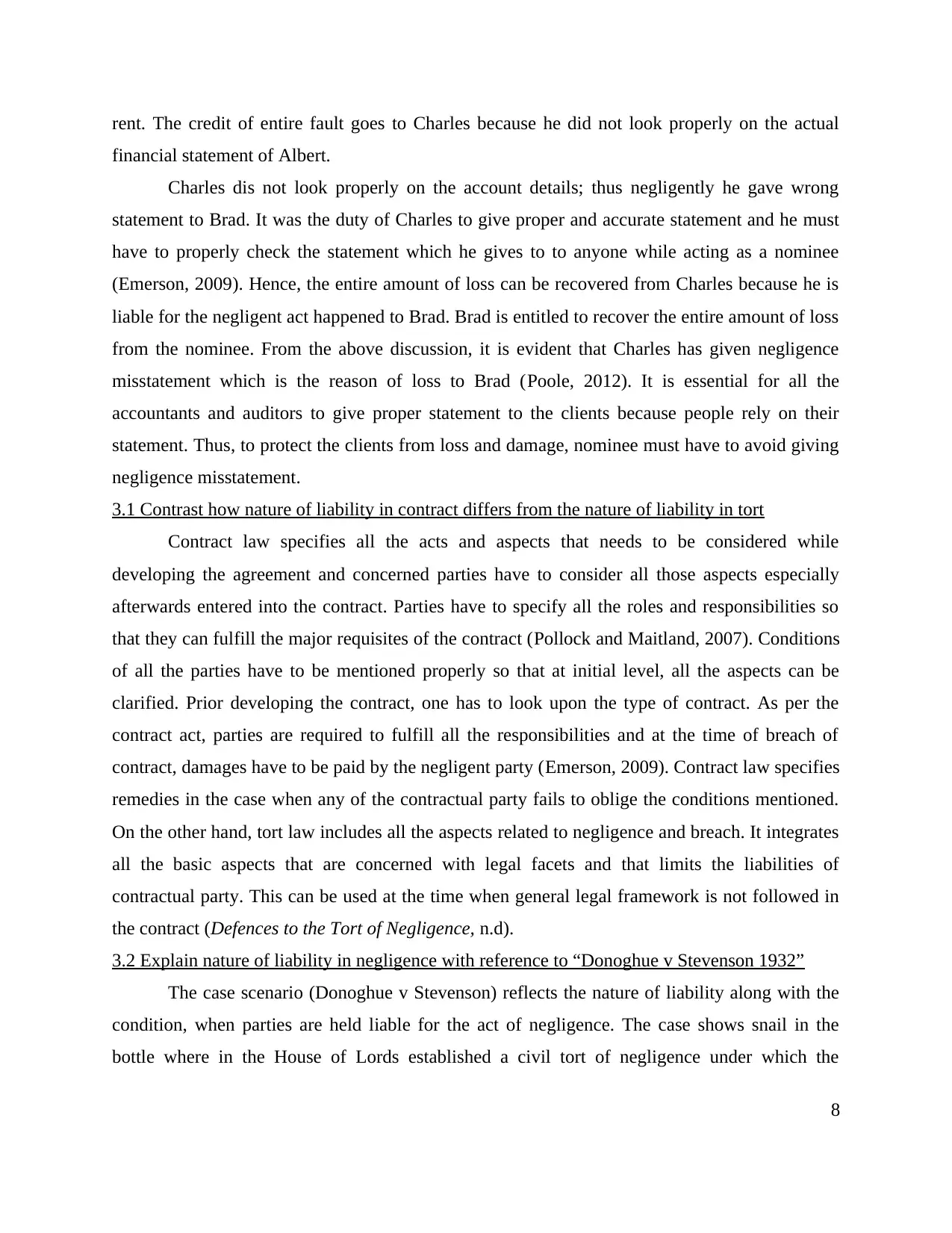
rent. The credit of entire fault goes to Charles because he did not look properly on the actual
financial statement of Albert.
Charles dis not look properly on the account details; thus negligently he gave wrong
statement to Brad. It was the duty of Charles to give proper and accurate statement and he must
have to properly check the statement which he gives to to anyone while acting as a nominee
(Emerson, 2009). Hence, the entire amount of loss can be recovered from Charles because he is
liable for the negligent act happened to Brad. Brad is entitled to recover the entire amount of loss
from the nominee. From the above discussion, it is evident that Charles has given negligence
misstatement which is the reason of loss to Brad (Poole, 2012). It is essential for all the
accountants and auditors to give proper statement to the clients because people rely on their
statement. Thus, to protect the clients from loss and damage, nominee must have to avoid giving
negligence misstatement.
3.1 Contrast how nature of liability in contract differs from the nature of liability in tort
Contract law specifies all the acts and aspects that needs to be considered while
developing the agreement and concerned parties have to consider all those aspects especially
afterwards entered into the contract. Parties have to specify all the roles and responsibilities so
that they can fulfill the major requisites of the contract (Pollock and Maitland, 2007). Conditions
of all the parties have to be mentioned properly so that at initial level, all the aspects can be
clarified. Prior developing the contract, one has to look upon the type of contract. As per the
contract act, parties are required to fulfill all the responsibilities and at the time of breach of
contract, damages have to be paid by the negligent party (Emerson, 2009). Contract law specifies
remedies in the case when any of the contractual party fails to oblige the conditions mentioned.
On the other hand, tort law includes all the aspects related to negligence and breach. It integrates
all the basic aspects that are concerned with legal facets and that limits the liabilities of
contractual party. This can be used at the time when general legal framework is not followed in
the contract (Defences to the Tort of Negligence, n.d).
3.2 Explain nature of liability in negligence with reference to “Donoghue v Stevenson 1932”
The case scenario (Donoghue v Stevenson) reflects the nature of liability along with the
condition, when parties are held liable for the act of negligence. The case shows snail in the
bottle where in the House of Lords established a civil tort of negligence under which the
8
financial statement of Albert.
Charles dis not look properly on the account details; thus negligently he gave wrong
statement to Brad. It was the duty of Charles to give proper and accurate statement and he must
have to properly check the statement which he gives to to anyone while acting as a nominee
(Emerson, 2009). Hence, the entire amount of loss can be recovered from Charles because he is
liable for the negligent act happened to Brad. Brad is entitled to recover the entire amount of loss
from the nominee. From the above discussion, it is evident that Charles has given negligence
misstatement which is the reason of loss to Brad (Poole, 2012). It is essential for all the
accountants and auditors to give proper statement to the clients because people rely on their
statement. Thus, to protect the clients from loss and damage, nominee must have to avoid giving
negligence misstatement.
3.1 Contrast how nature of liability in contract differs from the nature of liability in tort
Contract law specifies all the acts and aspects that needs to be considered while
developing the agreement and concerned parties have to consider all those aspects especially
afterwards entered into the contract. Parties have to specify all the roles and responsibilities so
that they can fulfill the major requisites of the contract (Pollock and Maitland, 2007). Conditions
of all the parties have to be mentioned properly so that at initial level, all the aspects can be
clarified. Prior developing the contract, one has to look upon the type of contract. As per the
contract act, parties are required to fulfill all the responsibilities and at the time of breach of
contract, damages have to be paid by the negligent party (Emerson, 2009). Contract law specifies
remedies in the case when any of the contractual party fails to oblige the conditions mentioned.
On the other hand, tort law includes all the aspects related to negligence and breach. It integrates
all the basic aspects that are concerned with legal facets and that limits the liabilities of
contractual party. This can be used at the time when general legal framework is not followed in
the contract (Defences to the Tort of Negligence, n.d).
3.2 Explain nature of liability in negligence with reference to “Donoghue v Stevenson 1932”
The case scenario (Donoghue v Stevenson) reflects the nature of liability along with the
condition, when parties are held liable for the act of negligence. The case shows snail in the
bottle where in the House of Lords established a civil tort of negligence under which the
8
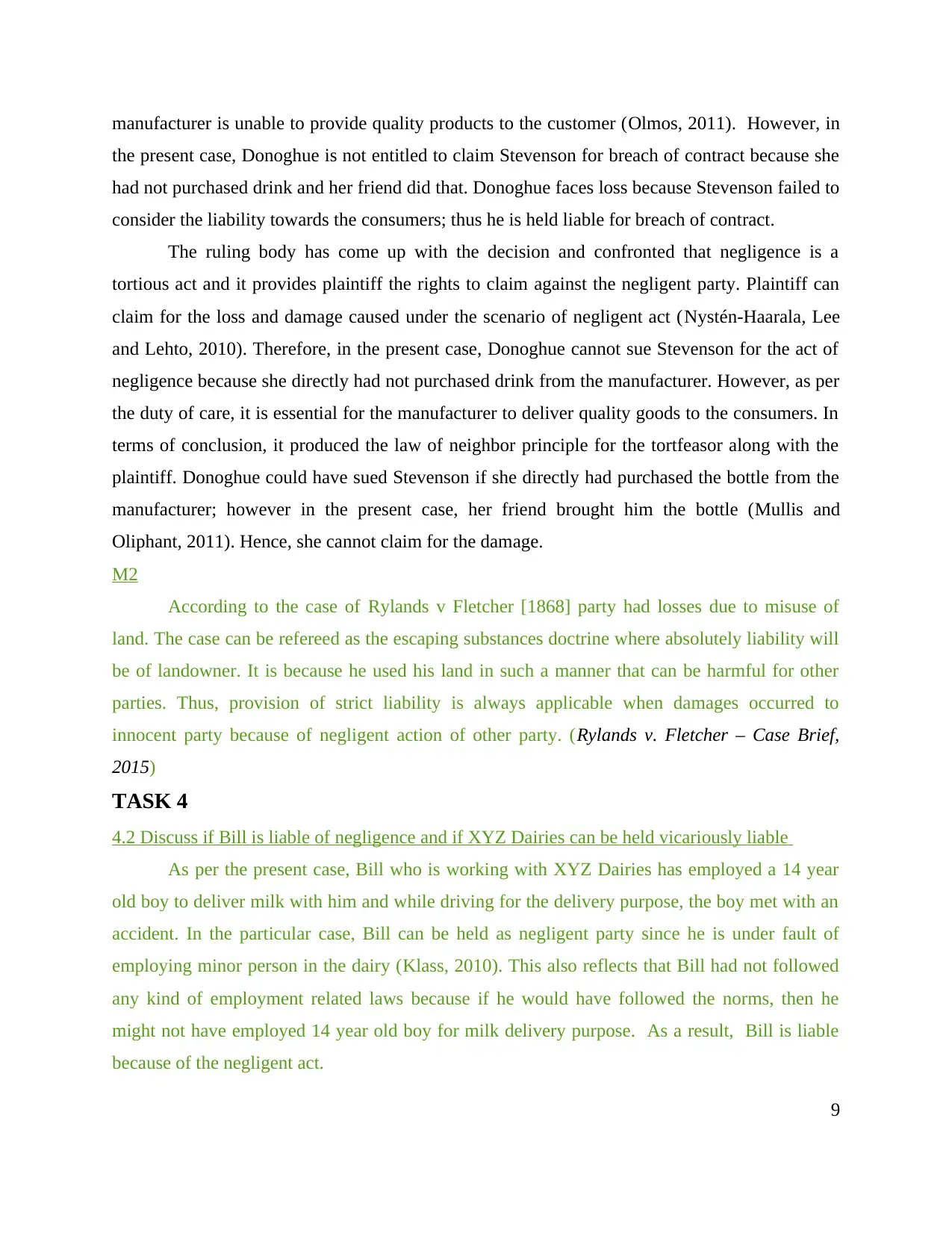
manufacturer is unable to provide quality products to the customer (Olmos, 2011). However, in
the present case, Donoghue is not entitled to claim Stevenson for breach of contract because she
had not purchased drink and her friend did that. Donoghue faces loss because Stevenson failed to
consider the liability towards the consumers; thus he is held liable for breach of contract.
The ruling body has come up with the decision and confronted that negligence is a
tortious act and it provides plaintiff the rights to claim against the negligent party. Plaintiff can
claim for the loss and damage caused under the scenario of negligent act (Nystén-Haarala, Lee
and Lehto, 2010). Therefore, in the present case, Donoghue cannot sue Stevenson for the act of
negligence because she directly had not purchased drink from the manufacturer. However, as per
the duty of care, it is essential for the manufacturer to deliver quality goods to the consumers. In
terms of conclusion, it produced the law of neighbor principle for the tortfeasor along with the
plaintiff. Donoghue could have sued Stevenson if she directly had purchased the bottle from the
manufacturer; however in the present case, her friend brought him the bottle (Mullis and
Oliphant, 2011). Hence, she cannot claim for the damage.
M2
According to the case of Rylands v Fletcher [1868] party had losses due to misuse of
land. The case can be refereed as the escaping substances doctrine where absolutely liability will
be of landowner. It is because he used his land in such a manner that can be harmful for other
parties. Thus, provision of strict liability is always applicable when damages occurred to
innocent party because of negligent action of other party. (Rylands v. Fletcher – Case Brief,
2015)
TASK 4
4.2 Discuss if Bill is liable of negligence and if XYZ Dairies can be held vicariously liable
As per the present case, Bill who is working with XYZ Dairies has employed a 14 year
old boy to deliver milk with him and while driving for the delivery purpose, the boy met with an
accident. In the particular case, Bill can be held as negligent party since he is under fault of
employing minor person in the dairy (Klass, 2010). This also reflects that Bill had not followed
any kind of employment related laws because if he would have followed the norms, then he
might not have employed 14 year old boy for milk delivery purpose. As a result, Bill is liable
because of the negligent act.
9
the present case, Donoghue is not entitled to claim Stevenson for breach of contract because she
had not purchased drink and her friend did that. Donoghue faces loss because Stevenson failed to
consider the liability towards the consumers; thus he is held liable for breach of contract.
The ruling body has come up with the decision and confronted that negligence is a
tortious act and it provides plaintiff the rights to claim against the negligent party. Plaintiff can
claim for the loss and damage caused under the scenario of negligent act (Nystén-Haarala, Lee
and Lehto, 2010). Therefore, in the present case, Donoghue cannot sue Stevenson for the act of
negligence because she directly had not purchased drink from the manufacturer. However, as per
the duty of care, it is essential for the manufacturer to deliver quality goods to the consumers. In
terms of conclusion, it produced the law of neighbor principle for the tortfeasor along with the
plaintiff. Donoghue could have sued Stevenson if she directly had purchased the bottle from the
manufacturer; however in the present case, her friend brought him the bottle (Mullis and
Oliphant, 2011). Hence, she cannot claim for the damage.
M2
According to the case of Rylands v Fletcher [1868] party had losses due to misuse of
land. The case can be refereed as the escaping substances doctrine where absolutely liability will
be of landowner. It is because he used his land in such a manner that can be harmful for other
parties. Thus, provision of strict liability is always applicable when damages occurred to
innocent party because of negligent action of other party. (Rylands v. Fletcher – Case Brief,
2015)
TASK 4
4.2 Discuss if Bill is liable of negligence and if XYZ Dairies can be held vicariously liable
As per the present case, Bill who is working with XYZ Dairies has employed a 14 year
old boy to deliver milk with him and while driving for the delivery purpose, the boy met with an
accident. In the particular case, Bill can be held as negligent party since he is under fault of
employing minor person in the dairy (Klass, 2010). This also reflects that Bill had not followed
any kind of employment related laws because if he would have followed the norms, then he
might not have employed 14 year old boy for milk delivery purpose. As a result, Bill is liable
because of the negligent act.
9
⊘ This is a preview!⊘
Do you want full access?
Subscribe today to unlock all pages.

Trusted by 1+ million students worldwide
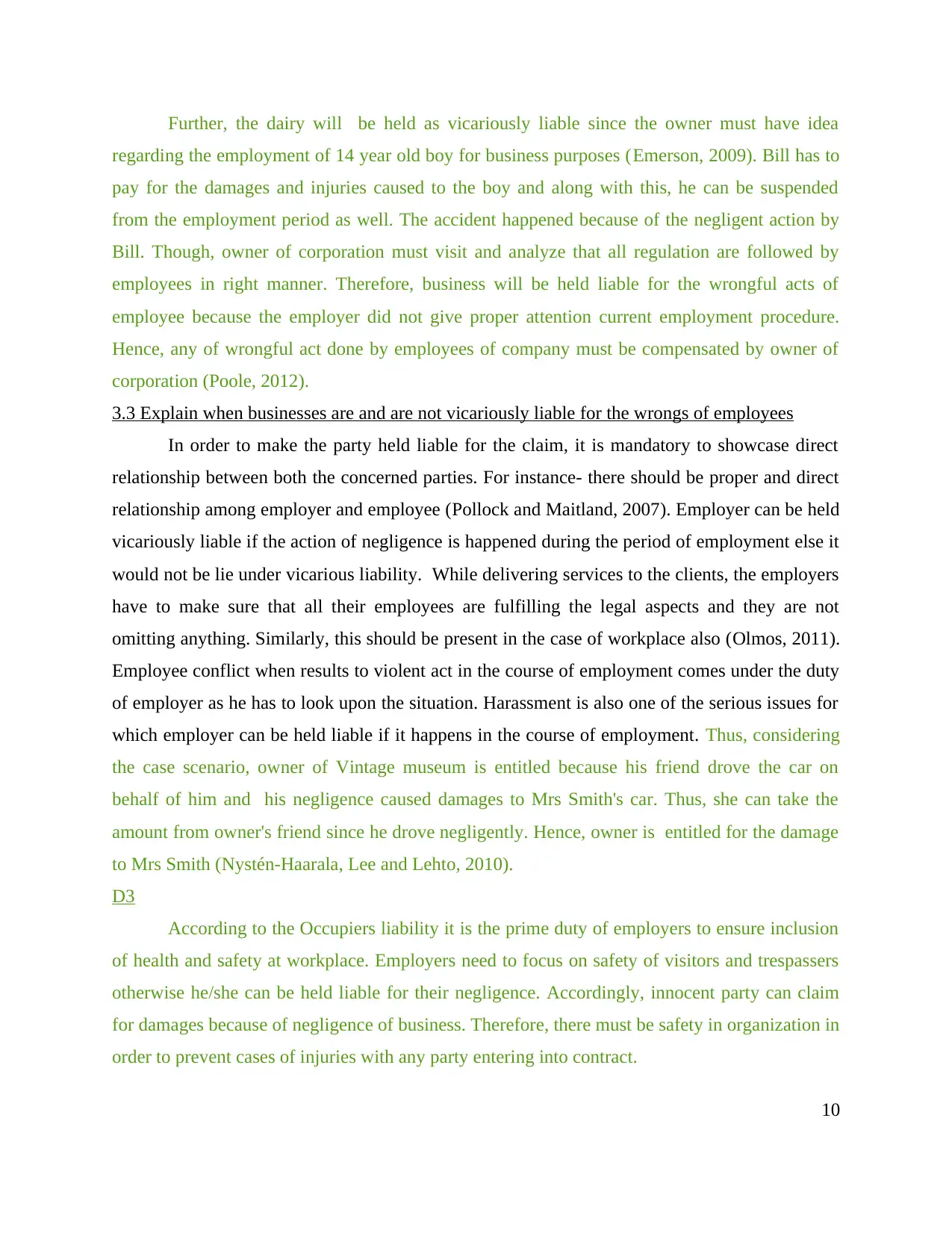
Further, the dairy will be held as vicariously liable since the owner must have idea
regarding the employment of 14 year old boy for business purposes (Emerson, 2009). Bill has to
pay for the damages and injuries caused to the boy and along with this, he can be suspended
from the employment period as well. The accident happened because of the negligent action by
Bill. Though, owner of corporation must visit and analyze that all regulation are followed by
employees in right manner. Therefore, business will be held liable for the wrongful acts of
employee because the employer did not give proper attention current employment procedure.
Hence, any of wrongful act done by employees of company must be compensated by owner of
corporation (Poole, 2012).
3.3 Explain when businesses are and are not vicariously liable for the wrongs of employees
In order to make the party held liable for the claim, it is mandatory to showcase direct
relationship between both the concerned parties. For instance- there should be proper and direct
relationship among employer and employee (Pollock and Maitland, 2007). Employer can be held
vicariously liable if the action of negligence is happened during the period of employment else it
would not be lie under vicarious liability. While delivering services to the clients, the employers
have to make sure that all their employees are fulfilling the legal aspects and they are not
omitting anything. Similarly, this should be present in the case of workplace also (Olmos, 2011).
Employee conflict when results to violent act in the course of employment comes under the duty
of employer as he has to look upon the situation. Harassment is also one of the serious issues for
which employer can be held liable if it happens in the course of employment. Thus, considering
the case scenario, owner of Vintage museum is entitled because his friend drove the car on
behalf of him and his negligence caused damages to Mrs Smith's car. Thus, she can take the
amount from owner's friend since he drove negligently. Hence, owner is entitled for the damage
to Mrs Smith (Nystén-Haarala, Lee and Lehto, 2010).
D3
According to the Occupiers liability it is the prime duty of employers to ensure inclusion
of health and safety at workplace. Employers need to focus on safety of visitors and trespassers
otherwise he/she can be held liable for their negligence. Accordingly, innocent party can claim
for damages because of negligence of business. Therefore, there must be safety in organization in
order to prevent cases of injuries with any party entering into contract.
10
regarding the employment of 14 year old boy for business purposes (Emerson, 2009). Bill has to
pay for the damages and injuries caused to the boy and along with this, he can be suspended
from the employment period as well. The accident happened because of the negligent action by
Bill. Though, owner of corporation must visit and analyze that all regulation are followed by
employees in right manner. Therefore, business will be held liable for the wrongful acts of
employee because the employer did not give proper attention current employment procedure.
Hence, any of wrongful act done by employees of company must be compensated by owner of
corporation (Poole, 2012).
3.3 Explain when businesses are and are not vicariously liable for the wrongs of employees
In order to make the party held liable for the claim, it is mandatory to showcase direct
relationship between both the concerned parties. For instance- there should be proper and direct
relationship among employer and employee (Pollock and Maitland, 2007). Employer can be held
vicariously liable if the action of negligence is happened during the period of employment else it
would not be lie under vicarious liability. While delivering services to the clients, the employers
have to make sure that all their employees are fulfilling the legal aspects and they are not
omitting anything. Similarly, this should be present in the case of workplace also (Olmos, 2011).
Employee conflict when results to violent act in the course of employment comes under the duty
of employer as he has to look upon the situation. Harassment is also one of the serious issues for
which employer can be held liable if it happens in the course of employment. Thus, considering
the case scenario, owner of Vintage museum is entitled because his friend drove the car on
behalf of him and his negligence caused damages to Mrs Smith's car. Thus, she can take the
amount from owner's friend since he drove negligently. Hence, owner is entitled for the damage
to Mrs Smith (Nystén-Haarala, Lee and Lehto, 2010).
D3
According to the Occupiers liability it is the prime duty of employers to ensure inclusion
of health and safety at workplace. Employers need to focus on safety of visitors and trespassers
otherwise he/she can be held liable for their negligence. Accordingly, innocent party can claim
for damages because of negligence of business. Therefore, there must be safety in organization in
order to prevent cases of injuries with any party entering into contract.
10
Paraphrase This Document
Need a fresh take? Get an instant paraphrase of this document with our AI Paraphraser
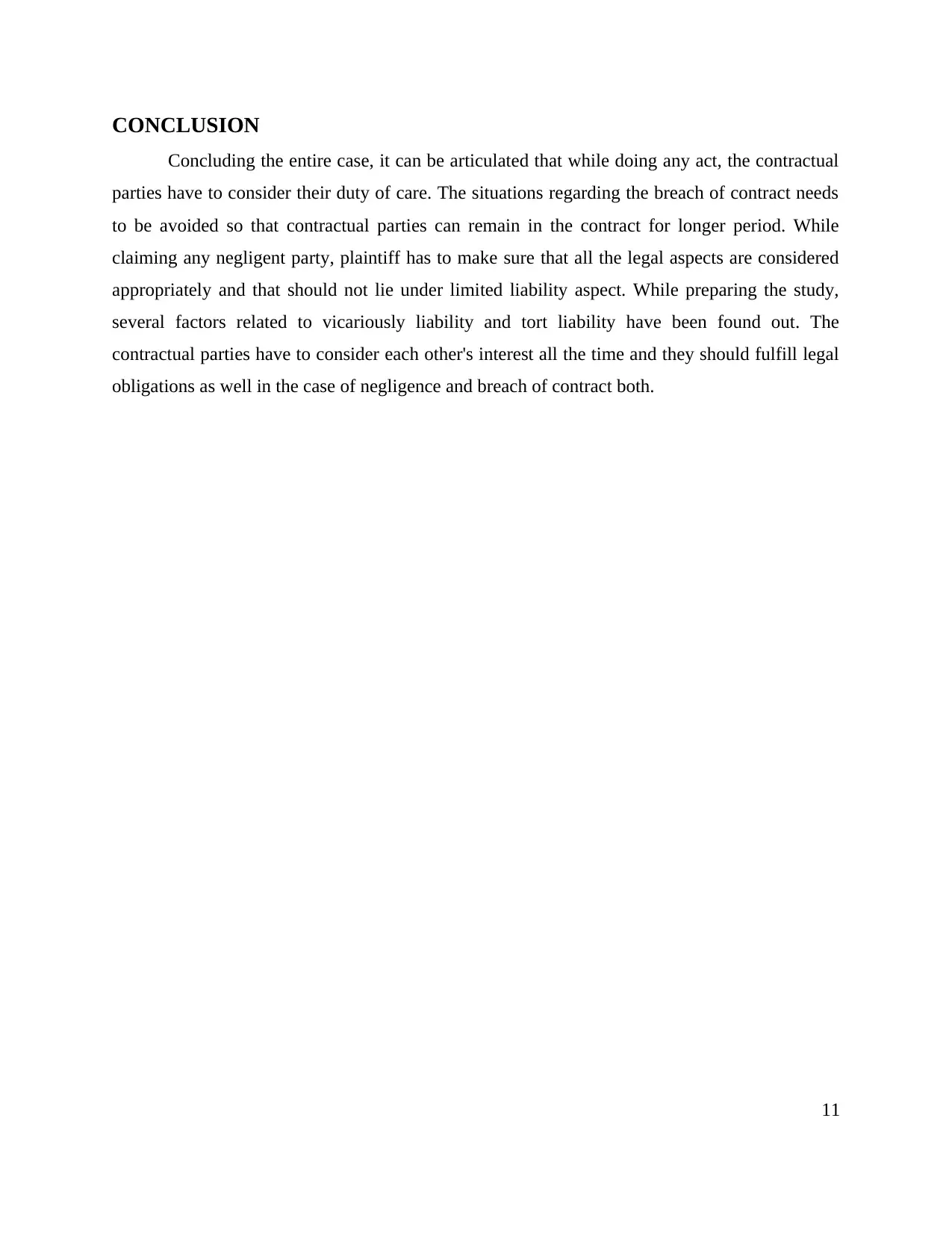
CONCLUSION
Concluding the entire case, it can be articulated that while doing any act, the contractual
parties have to consider their duty of care. The situations regarding the breach of contract needs
to be avoided so that contractual parties can remain in the contract for longer period. While
claiming any negligent party, plaintiff has to make sure that all the legal aspects are considered
appropriately and that should not lie under limited liability aspect. While preparing the study,
several factors related to vicariously liability and tort liability have been found out. The
contractual parties have to consider each other's interest all the time and they should fulfill legal
obligations as well in the case of negligence and breach of contract both.
11
Concluding the entire case, it can be articulated that while doing any act, the contractual
parties have to consider their duty of care. The situations regarding the breach of contract needs
to be avoided so that contractual parties can remain in the contract for longer period. While
claiming any negligent party, plaintiff has to make sure that all the legal aspects are considered
appropriately and that should not lie under limited liability aspect. While preparing the study,
several factors related to vicariously liability and tort liability have been found out. The
contractual parties have to consider each other's interest all the time and they should fulfill legal
obligations as well in the case of negligence and breach of contract both.
11
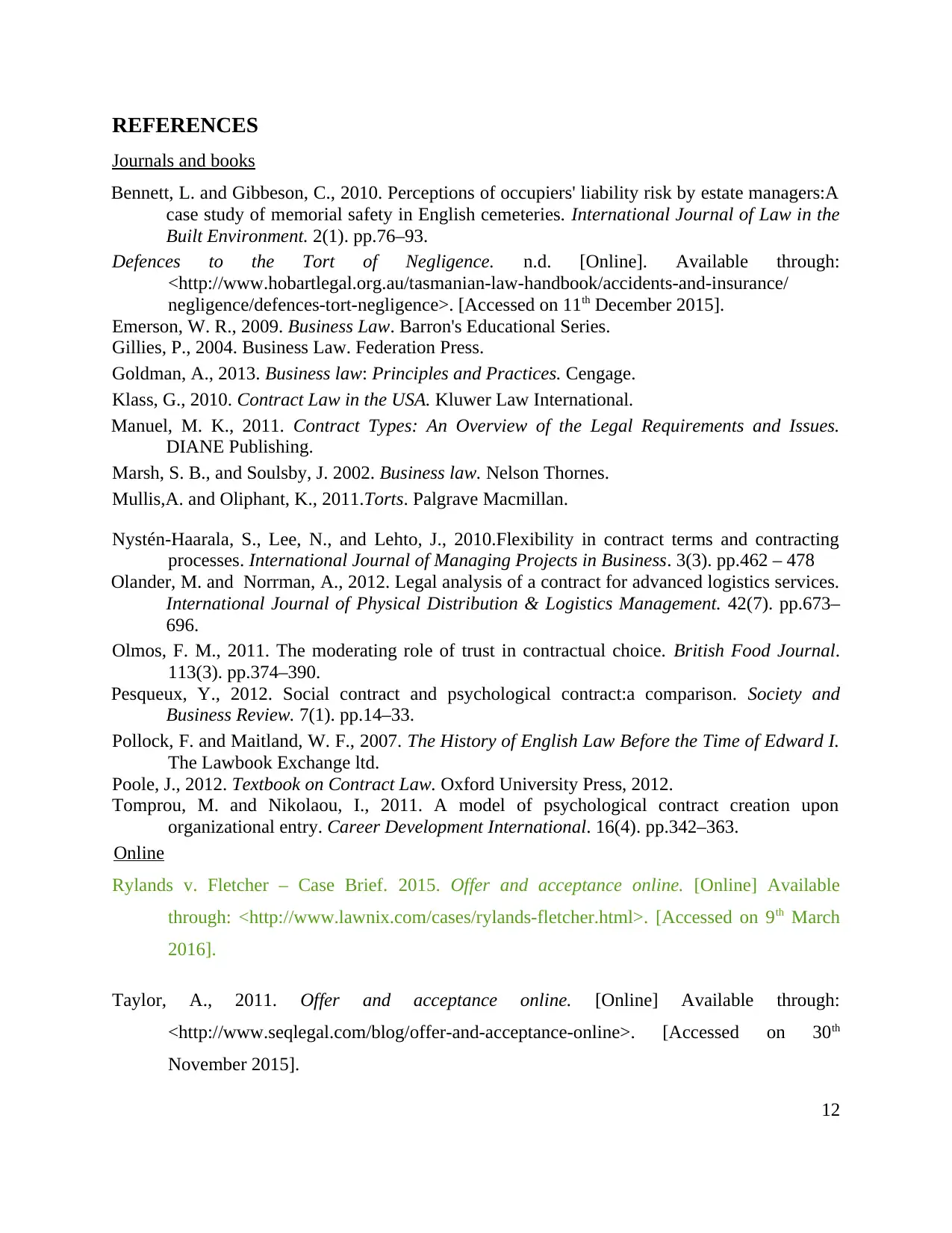
REFERENCES
Journals and books
Bennett, L. and Gibbeson, C., 2010. Perceptions of occupiers' liability risk by estate managers:A
case study of memorial safety in English cemeteries. International Journal of Law in the
Built Environment. 2(1). pp.76–93.
Defences to the Tort of Negligence. n.d. [Online]. Available through:
<http://www.hobartlegal.org.au/tasmanian-law-handbook/accidents-and-insurance/
negligence/defences-tort-negligence>. [Accessed on 11th December 2015].
Emerson, W. R., 2009. Business Law. Barron's Educational Series.
Gillies, P., 2004. Business Law. Federation Press.
Goldman, A., 2013. Business law: Principles and Practices. Cengage.
Klass, G., 2010. Contract Law in the USA. Kluwer Law International.
Manuel, M. K., 2011. Contract Types: An Overview of the Legal Requirements and Issues.
DIANE Publishing.
Marsh, S. B., and Soulsby, J. 2002. Business law. Nelson Thornes.
Mullis,A. and Oliphant, K., 2011.Torts. Palgrave Macmillan.
Nystén-Haarala, S., Lee, N., and Lehto, J., 2010.Flexibility in contract terms and contracting
processes. International Journal of Managing Projects in Business. 3(3). pp.462 – 478
Olander, M. and Norrman, A., 2012. Legal analysis of a contract for advanced logistics services.
International Journal of Physical Distribution & Logistics Management. 42(7). pp.673–
696.
Olmos, F. M., 2011. The moderating role of trust in contractual choice. British Food Journal.
113(3). pp.374–390.
Pesqueux, Y., 2012. Social contract and psychological contract:a comparison. Society and
Business Review. 7(1). pp.14–33.
Pollock, F. and Maitland, W. F., 2007. The History of English Law Before the Time of Edward I.
The Lawbook Exchange ltd.
Poole, J., 2012. Textbook on Contract Law. Oxford University Press, 2012.
Tomprou, M. and Nikolaou, I., 2011. A model of psychological contract creation upon
organizational entry. Career Development International. 16(4). pp.342–363.
Online
Rylands v. Fletcher – Case Brief. 2015. Offer and acceptance online. [Online] Available
through: <http://www.lawnix.com/cases/rylands-fletcher.html>. [Accessed on 9th March
2016].
Taylor, A., 2011. Offer and acceptance online. [Online] Available through:
<http://www.seqlegal.com/blog/offer-and-acceptance-online>. [Accessed on 30th
November 2015].
12
Journals and books
Bennett, L. and Gibbeson, C., 2010. Perceptions of occupiers' liability risk by estate managers:A
case study of memorial safety in English cemeteries. International Journal of Law in the
Built Environment. 2(1). pp.76–93.
Defences to the Tort of Negligence. n.d. [Online]. Available through:
<http://www.hobartlegal.org.au/tasmanian-law-handbook/accidents-and-insurance/
negligence/defences-tort-negligence>. [Accessed on 11th December 2015].
Emerson, W. R., 2009. Business Law. Barron's Educational Series.
Gillies, P., 2004. Business Law. Federation Press.
Goldman, A., 2013. Business law: Principles and Practices. Cengage.
Klass, G., 2010. Contract Law in the USA. Kluwer Law International.
Manuel, M. K., 2011. Contract Types: An Overview of the Legal Requirements and Issues.
DIANE Publishing.
Marsh, S. B., and Soulsby, J. 2002. Business law. Nelson Thornes.
Mullis,A. and Oliphant, K., 2011.Torts. Palgrave Macmillan.
Nystén-Haarala, S., Lee, N., and Lehto, J., 2010.Flexibility in contract terms and contracting
processes. International Journal of Managing Projects in Business. 3(3). pp.462 – 478
Olander, M. and Norrman, A., 2012. Legal analysis of a contract for advanced logistics services.
International Journal of Physical Distribution & Logistics Management. 42(7). pp.673–
696.
Olmos, F. M., 2011. The moderating role of trust in contractual choice. British Food Journal.
113(3). pp.374–390.
Pesqueux, Y., 2012. Social contract and psychological contract:a comparison. Society and
Business Review. 7(1). pp.14–33.
Pollock, F. and Maitland, W. F., 2007. The History of English Law Before the Time of Edward I.
The Lawbook Exchange ltd.
Poole, J., 2012. Textbook on Contract Law. Oxford University Press, 2012.
Tomprou, M. and Nikolaou, I., 2011. A model of psychological contract creation upon
organizational entry. Career Development International. 16(4). pp.342–363.
Online
Rylands v. Fletcher – Case Brief. 2015. Offer and acceptance online. [Online] Available
through: <http://www.lawnix.com/cases/rylands-fletcher.html>. [Accessed on 9th March
2016].
Taylor, A., 2011. Offer and acceptance online. [Online] Available through:
<http://www.seqlegal.com/blog/offer-and-acceptance-online>. [Accessed on 30th
November 2015].
12
⊘ This is a preview!⊘
Do you want full access?
Subscribe today to unlock all pages.

Trusted by 1+ million students worldwide
1 out of 13
Related Documents
Your All-in-One AI-Powered Toolkit for Academic Success.
+13062052269
info@desklib.com
Available 24*7 on WhatsApp / Email
![[object Object]](/_next/static/media/star-bottom.7253800d.svg)
Unlock your academic potential
Copyright © 2020–2025 A2Z Services. All Rights Reserved. Developed and managed by ZUCOL.





